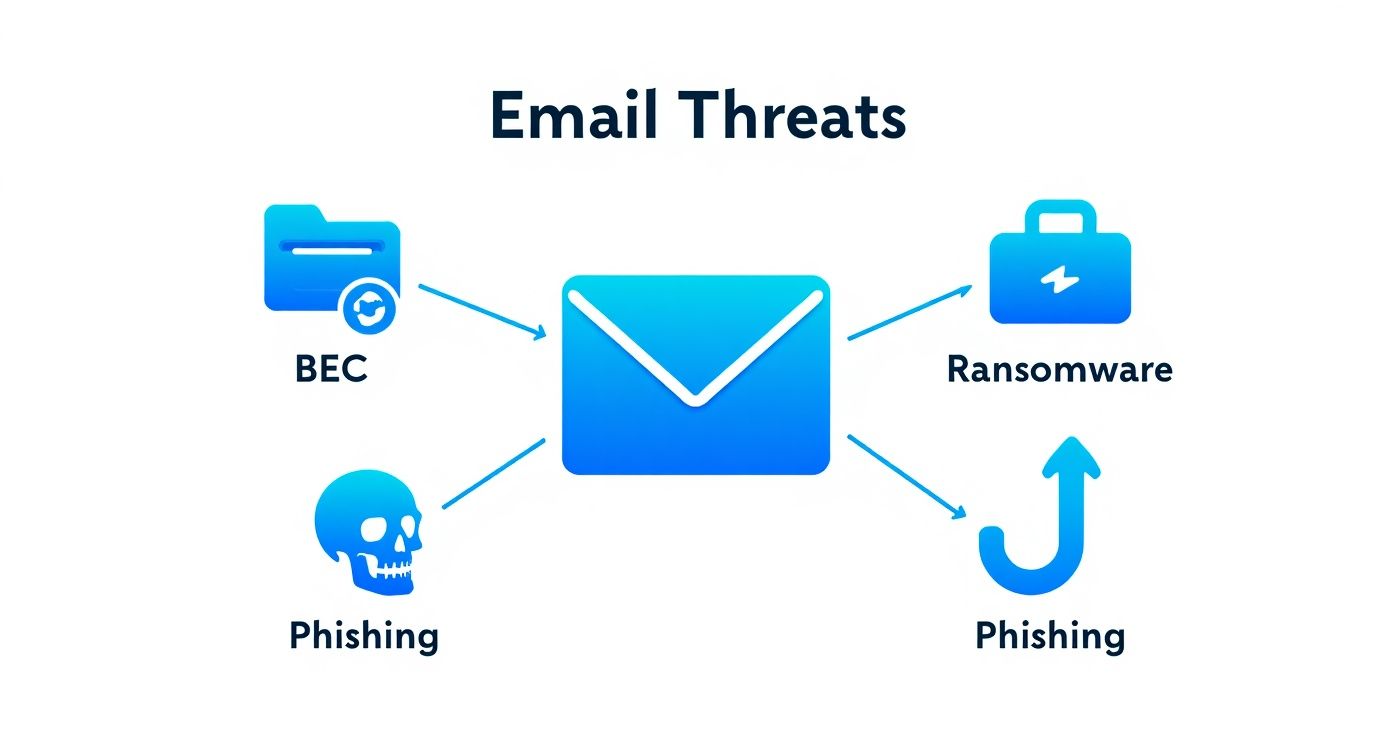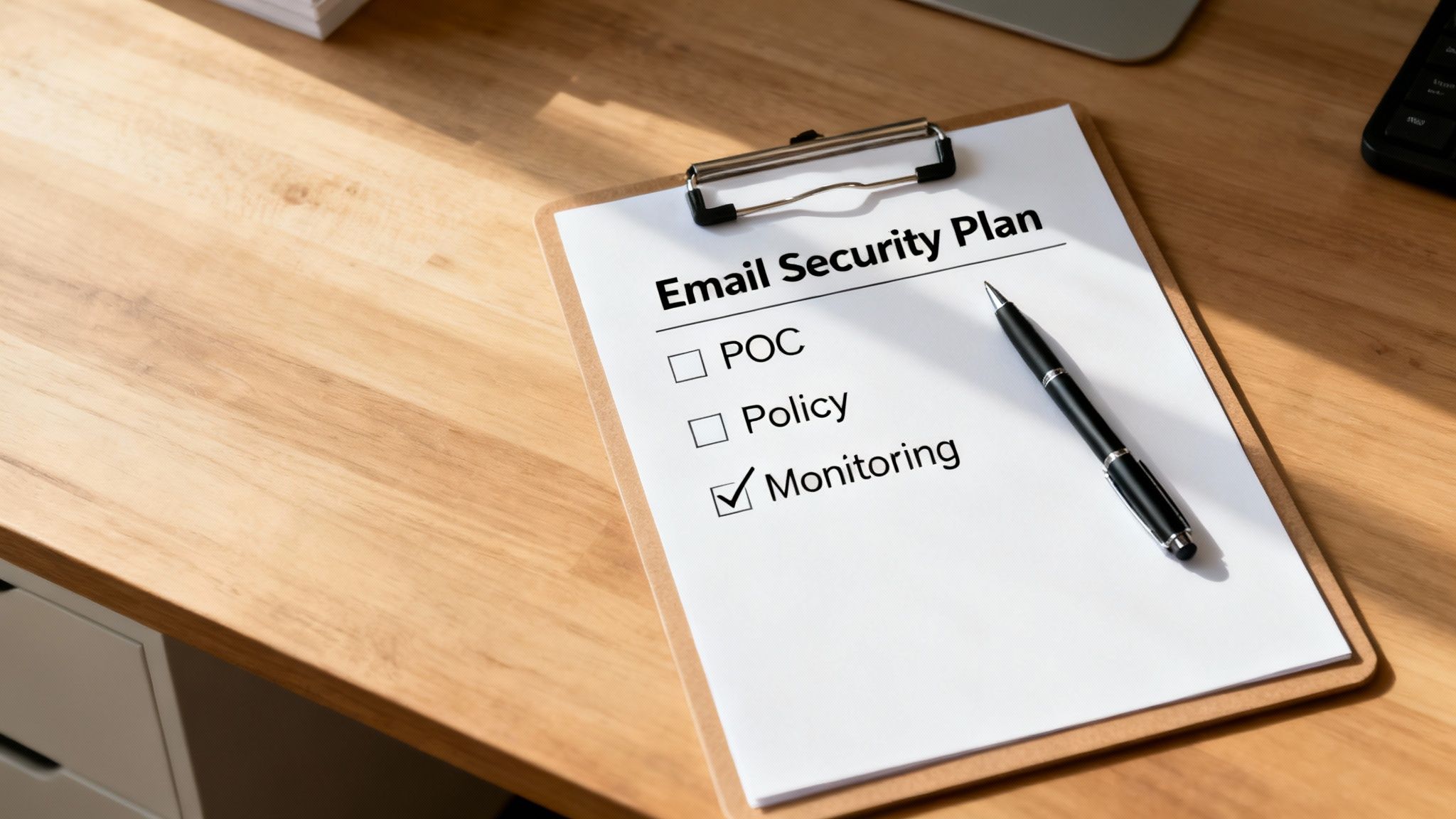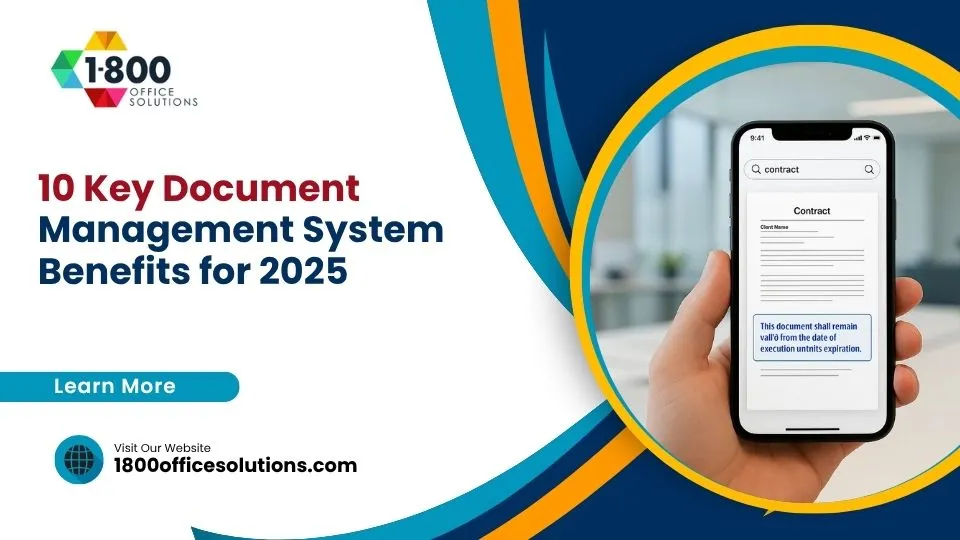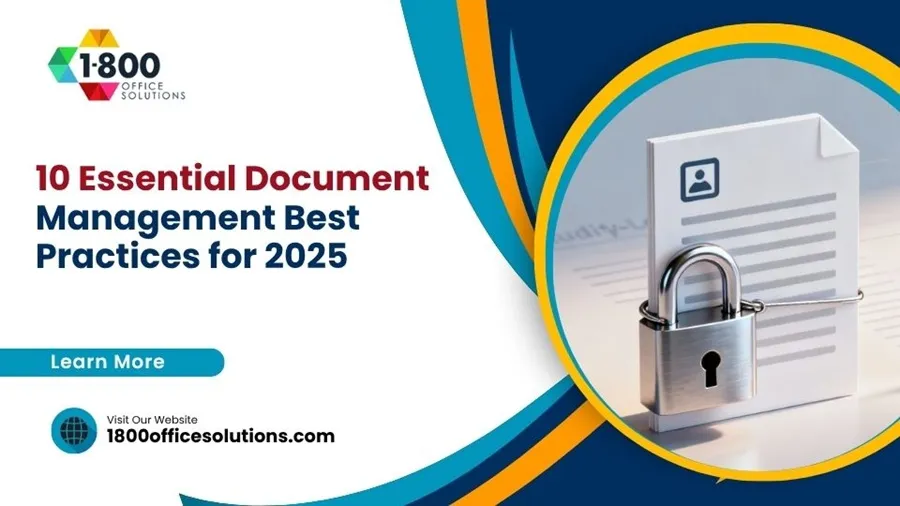Finding the Best Email Security Solutions for Your Business
AI Overview:
Email is the top entry point for modern cyberattacks like phishing, ransomware, and Business Email Compromise (BEC). This blog explains why built-in protections alone aren’t enough and why businesses need a multi-layered email security strategy powered by AI.
It covers the main solution types—Secure Email Gateways, Cloud Email Security tools, SPF/DKIM/DMARC authentication, encryption, and Managed Detection & Response (MDR)—and highlights must-have features such as AI threat detection, anti-spoofing, sandboxing, DLP, and system integrations.
The guide also helps businesses choose the right solution based on size and needs, outlines implementation steps, and emphasizes the value of managed security services for ongoing monitoring and protection.
Selecting the best email security solution is no longer about just blocking spam; it’s a critical business decision to defend against sophisticated threats like phishing, ransomware, and Business Email Compromise (BEC). Effective protection requires a strategic defense that uses advanced AI to detect modern attacks, integrates seamlessly with existing systems, and provides robust tools for email authentication and data loss prevention.
Relying solely on the default protections included with your email service is insufficient. A multi-layered security strategy is essential to safeguard your most vital communication channel from determined cybercriminals. This guide will provide a clear roadmap to help you evaluate, choose, and implement the right solution for your organization.
Why Your Business Needs Advanced Email Security
Email remains the primary vector for cyberattacks, making robust security a non-negotiable component of modern business operations. While the built-in filters from email providers offer a baseline level of protection, they cannot keep pace with the evolving tactics of financially motivated attackers.
Today’s threats are highly targeted, financially devastating, and have evolved far beyond simple spam. Investing in a dedicated solution is a matter of operational survival and sustainable growth. It is the equivalent of upgrading from a standard door lock to a comprehensive security system for your most critical business asset. Advanced tools are vital not only for filtering malware but also to protect against Business Email Compromise (BEC), a particularly dangerous threat that can result in catastrophic financial losses.
The Escalating Threat Environment
The volume and sophistication of email-based attacks are staggering. Every day, organizations face a constant barrage of threats designed to steal credentials, deploy ransomware, or trick employees into making fraudulent wire transfers. This is not merely a technical issue—it represents a significant financial and reputational risk.
The growing danger has spurred significant investment in stronger defenses. The global email security market reached USD 4.68 billion in 2024 and is projected to climb to USD 10.68 billion by 2032. This rapid growth underscores a clear trend: businesses recognize the urgent need for more effective protection.
Proactive defense is critical. Reacting after a threat has already breached your defenses is a losing strategy that leads directly to operational downtime, data loss, and eroded customer trust.
Moving Beyond Basic Protections
A modern security strategy requires layers of defense tailored to your specific operational needs. Choosing the right solution involves understanding the current threat environment, identifying core features, and aligning the technology with your business objectives.
Furthermore, strong email security is a cornerstone of regulatory compliance. For a deeper analysis, you can learn why email security matters for ISO 27001. This guide will equip you with a clear framework for making an informed decision and building a defense resilient enough to withstand future attacks.
Understanding the Core Types of Email Security Solutions
Navigating the market for the best email security solution can feel overwhelming, but the process becomes much clearer when you understand the primary categories of tools available. Each solution performs a specific function within a layered defense strategy. Think of it less like buying a single product and more like assembling a specialized security team for your digital communications.
Just as a physical building requires different security specialists for the perimeter, surveillance, and incident response, your email requires a similar multi-faceted approach. Some tools act as frontline guards, while others work behind the scenes as detectives verifying identities. The threats they are designed to stop—from Business Email Compromise (BEC) to ransomware—can cripple a company if left unchecked.

As this data shows, email is ground zero for cyberattacks that cause massive financial and operational disruption. Let’s break down the key components of a comprehensive defense.
To provide a quick overview, here is how the main solution types compare.
Comparing Core Email Security Solution Types
| Solution Type | Primary Function | Best For | Deployment Model |
|---|---|---|---|
| Secure Email Gateway (SEG) | Scans all inbound/outbound email traffic at the network perimeter. | Filtering known threats like spam, viruses, and bulk phishing. | On-premises appliance or cloud service (via MX record change). |
| Cloud Email Security (CES) | Integrates directly into cloud email platforms to detect advanced threats. | Catching sophisticated, payload-free attacks like BEC and account takeovers. | API-based integration with Microsoft 365 or Google Workspace. |
| SPF, DKIM, & DMARC | Authenticates sender identity to prevent domain spoofing and impersonation. | Protecting an organization’s brand reputation and stopping phishing. | DNS record configuration. |
| Email Encryption | Scrambles email content to ensure confidentiality. | Securing sensitive data in transit and at rest. | Integrated into gateways, cloud platforms, or standalone clients. |
| MDR for Email | Provides 24/7 expert monitoring, threat hunting, and incident response. | Businesses without a dedicated, round-the-clock security operations team. | Service-based, managed by a third-party provider. |
Each of these solutions plays a unique and critical role. Now, let’s explore what each one does in more detail.
Secure Email Gateways (SEGs)
A Secure Email Gateway (SEG) functions as the traditional gatekeeper for your email system. It acts as a dedicated checkpoint, forcing all incoming and outgoing messages to pass through it for inspection. Before an email reaches an employee’s inbox, the SEG scans it for known malware, spam, phishing links, and other commodity threats.
While SEGs remain effective for filtering high-volume, known threats, the nature of cyberattacks has evolved. Today’s most damaging attacks, such as a well-crafted BEC email, often contain no malicious link or attachment for a traditional SEG to detect. This is where their limitations become apparent.
Cloud Email Security Supplements
To address the gaps left by both native email security (from providers like Microsoft and Google) and traditional SEGs, a new category of tools has emerged: Cloud Email Security supplements. Instead of sitting at the network perimeter, these solutions integrate directly into cloud platforms like Microsoft 365 and Google Workspace via APIs.
This direct integration is a game-changer. It allows these tools to analyze internal email traffic—something an SEG cannot see—and identify the subtle indicators of an account takeover or a sophisticated impersonation attempt. For a comprehensive overview, read our complete guide to cloud-based email security and safety. By learning an organization’s normal communication patterns, they can flag anomalies that would otherwise go unnoticed.
Authentication Protocols SPF DKIM and DMARC
These three protocols—Sender Policy Framework (SPF), DomainKeys Identified Mail (DKIM), and Domain-based Message Authentication, Reporting, and Conformance (DMARC)—form the foundation of modern email authentication. They work in concert to prevent criminals from spoofing your email domain and impersonating your brand.
Think of DMARC as a digital passport for your email domain. It provides explicit instructions to receiving mail servers on how to handle a message that claims to be from you but fails SPF or DKIM identity verification. It is your way of saying, “If the passport appears forged, reject it.”
Implementing these protocols is a non-negotiable first step for any business. It protects your brand reputation and closes a major loophole exploited in phishing attacks.
Email Encryption
When transmitting sensitive information—such as financial records, patient data, or proprietary intellectual property—email encryption is essential. It transforms the message into an unreadable code that can only be unlocked and read by the intended recipient, who possesses the unique decryption key.
This process ensures that even if a message is intercepted, its contents remain confidential and useless to unauthorized parties. Encryption is typically applied in two ways:
- In-transit encryption (TLS): This is the standard method, analogous to sending mail in a sealed truck. It protects the email as it travels between servers.
- End-to-end encryption (S/MIME or PGP): This is like placing the letter itself in a locked box before it enters the truck. The message is secured from the moment of sending until the recipient opens it, meaning not even email providers can access the contents.
Managed Detection and Response (MDR) for Email
For businesses without a large, in-house security team operating around the clock, Managed Detection and Response (MDR) services offer a powerful solution. An MDR provider acts as a seamless extension of your IT team, delivering 24/7 monitoring, threat hunting, and incident response focused specifically on your email environment.
This is more than just a software purchase; it is an investment in a security outcome. Real human experts manage the setup, monitor for threats, investigate every alert, and take decisive action on your behalf. This provides enterprise-grade protection without the associated overhead, freeing your internal team to focus on strategic business initiatives.
Essential Features of Top Email Security Platforms
When evaluating email security solutions, it is crucial to look past marketing claims and focus on the features that effectively stop modern attacks. The best platforms are distinguished by their ability to detect threats that bypass traditional defenses, integrate smoothly into your existing operations, and provide clear, actionable intelligence. The ideal solution combines intelligent technology with a user-friendly design.
By using the following core functions as a checklist, you can make an informed decision and invest in genuine protection rather than a false sense of security.
AI-Powered Threat Detection
Signature-based antivirus and simple rule-based filters are no longer sufficient. Cybercriminals constantly generate new malware variants (zero-day threats) and craft highly convincing phishing emails that contain no obvious malicious payload. This is precisely where artificial intelligence and machine learning become indispensable.
An AI-driven engine analyzes communication patterns, sender reputations, language, and email structure to identify the subtle anomalies indicative of an attack. It is the difference between a security guard checking IDs against a list and a seasoned detective who can recognize suspicious behavior from a distance. This capability is your primary defense against sophisticated BEC attacks and spear-phishing campaigns.
Anti-Spoofing and BEC Protection
Business Email Compromise (BEC) attacks are predicated on impersonation—tricking employees into believing a fraudulent request comes from a trusted source. The strongest security platforms employ multiple layers of defense to neutralize this threat.
- DMARC Enforcement: The platform should not only check for DMARC records but also provide tools to easily deploy and manage your own DMARC policy.
- Behavioral Analysis: AI models establish a baseline of normal email traffic and instantly flag messages with unusual language, timing, or urgent financial requests that deviate from established patterns.
- Impersonation Detection: The system must be sophisticated enough to detect subtle variations in display names or “lookalike” domains designed to deceive the human eye.
These features work together to verify sender identity and intent, effectively closing the door on the tactics used in these incredibly costly attacks.
Advanced Ransomware Defense
Email is the most common delivery vector for ransomware, which is typically concealed in an attachment or a malicious link. A top-tier solution requires more than basic file scanning; it must be proactive. The single most important tool for this is sandboxing.
Sandboxing provides a secure, isolated environment for your email. When a suspicious file or link is detected, the security platform opens it within this controlled space to observe its behavior. If it attempts to encrypt files or contact a malicious server, it is blocked immediately—long before it can reach an end user.
This proactive detonation transforms a potential network-wide disaster into a non-event.
Data Loss Prevention and Integration
Effective security is not only about stopping inbound threats; it is also about preventing sensitive data from leaving the organization. Data Loss Prevention (DLP) capabilities are essential for this purpose. DLP policies scan outgoing emails for confidential information, such as credit card numbers, social security numbers, or proprietary company data.
Furthermore, a security tool cannot operate in isolation. It must integrate seamlessly with the rest of your IT infrastructure. The best email security solutions offer API connections to other systems, including:
- SIEM (Security Information and Event Management): To centralize all security logs and alerts.
- SOAR (Security Orchestration, Automation, and Response): To automate incident response workflows and accelerate your team’s reaction time.
These integrations provide a unified view of your security posture and enable a faster, more coordinated response to incidents. They also connect to broader security strategies, such as those detailed in our access management solutions.
The demand for these integrated tools is growing rapidly. Projections show the global email security market increasing from USD 18.5 billion in 2024 to USD 24 billion by 2030, with managed services experiencing even faster growth to meet the demand for expert security operations. You can read the full analysis on the email security market growth.
Intuitive Admin Experience and Reporting
Ultimately, even the most powerful tool is ineffective if it is difficult to manage. A clean, intuitive administration dashboard is essential. Your IT team must be able to configure policies, investigate incidents, and generate meaningful reports without requiring specialized expertise in the platform.
The goal is to strike a balance between a high detection accuracy and a low rate of false positives. A tool that frequently quarantines legitimate business emails creates unnecessary work for IT staff and frustrates users. Clear reporting is what allows you to fine-tune the system, demonstrate its value, and ensure it is protecting your company without hindering productivity.
How to Choose the Right Solution for Your Business
Selecting the right email security solution is not about finding a single “best” product but about identifying the right fit for your organization. A small business with a generalist IT professional has vastly different requirements than a large enterprise with a dedicated security operations center. Recognizing this distinction is key to making a sound investment.
The objective is to align a solution’s capabilities—from its management interface to its integration with other software—with your operational reality, budget, and regulatory obligations. A mismatch can result in a tool that is either too basic to stop real threats or so complex that it cannot be managed effectively, leaving your organization exposed.
Tailored Guidance for Small and Mid-Sized Businesses (SMBs)
For small and mid-sized businesses, the ideal email security tool delivers robust protection without a steep learning curve or constant maintenance. Since most SMBs lack a dedicated security team, the priorities are efficiency, affordability, and simplicity.
Your primary focus should be on a platform that automates as much of the administrative work as possible. Look for solutions that are easy to set up, feature an intuitive dashboard, and provide actionable reports. A tool that adds to the workload of an already overextended IT generalist is the wrong choice.
Key priorities for SMBs typically include:
- Ease of Use: A clean, simple interface for configuring rules and reviewing incidents without specialized certification.
- Automated Remediation: The ability to automatically remove malicious emails from all inboxes, even after delivery.
- Comprehensive Protection: A single solution that addresses all major threats, including phishing, BEC, ransomware, and spoofing.
- Affordability: Clear, predictable pricing that fits a smaller budget without compromising essential security features.
Many businesses begin with integrated platforms that bundle email with other productivity tools. As part of your selection process, exploring options like Microsoft 365 security features is a practical first step, often supplemented with a specialized third-party tool to address more advanced threats.
Critical Considerations for Large Enterprises
Enterprises operate on a different scale and face unique challenges. With thousands of employees, a complex IT ecosystem, and stringent compliance requirements, their focus shifts to scalability, deep customization, and seamless integration. For a large organization, an email security solution must function as a well-integrated component of a much larger security architecture.
Granular policy control is paramount. The ability to create highly specific rules for different departments, user groups, or data types is non-negotiable. Enterprises also require solutions that can integrate directly with their existing SIEM, SOAR, and threat intelligence platforms to create a unified, automated defense system.
An enterprise-grade solution must provide not just protection, but also deep visibility. The ability to hunt for threats, analyze attack trends, and generate detailed reports for compliance audits is a core requirement.
Key priorities for enterprises include:
- Scalability: The capacity to handle a massive volume of email from a global workforce without performance degradation.
- Advanced Customization: The power to tailor policies to meet the unique needs of different business units and satisfy complex regulations like HIPAA or GDPR.
- Deep Integration: Robust APIs that enable data sharing and interoperability with other security tools in the stack.
- Advanced Analytics and Reporting: Powerful tools for threat hunting, incident investigation, and generating the detailed reports required for audits.
This demand for more sophisticated protection is driving significant market growth. Research predicts the email security market will expand by approximately USD 6.03 billion at a compound annual growth rate of 14.2% between 2024 and 2029, with industries like financial services leading the adoption. You can discover more insights about email security market trends to understand how digital transformation is increasing corporate vulnerability.
Creating Your Email Security Implementation Plan
Selecting a superior email security solution is only half the battle; successful implementation is the other. This process is not merely a technical task—it is a strategic initiative. A rushed or disorganized deployment can create significant security gaps and cause widespread business disruption. A clear, well-structured plan is essential for a smooth transition to a stronger defensive posture.
The process begins with a thorough assessment of your current environment and concludes with ongoing monitoring to ensure the new system operates at peak performance. It involves aligning your technology, policies, and personnel for a major security upgrade.

Running a Proof of Concept
Before committing to a long-term contract, it is imperative to conduct a proof-of-concept (POC). Select your top two or three vendors and test their solutions in your live environment. A POC serves as the ultimate evaluation, allowing you to see firsthand how a solution performs with your actual email traffic. It cuts through marketing claims and provides empirical results.
During the POC, focus on the metrics that truly matter:
- Threat Detection Accuracy: How effectively does it detect phishing, BEC, and malware compared to your current system?
- False Positive Rate: How often does it incorrectly flag legitimate emails, and how much time will your team spend remediating these errors?
- Administrative Overhead: Is the management dashboard intuitive? How much of your team’s time will be required for policy tuning and alert management?
A successful POC provides the hard data needed to justify the investment and demonstrate that the new solution offers a significant improvement in both protection and efficiency.
Developing a Robust Email Security Policy
Technology alone is not enough. It must be supported by clear, enforceable policies that guide employee behavior. A strong email security policy is the foundation of your security program, establishing the rules of engagement and outlining procedures for handling suspicious activity. This document is key to fostering a security-conscious culture.
Your policy should be simple and easily understood by all employees. It should cover several critical areas:
- Acceptable Use Guidelines: Clearly define what employees can and cannot do with their company email, such as prohibiting the forwarding of sensitive data to personal accounts.
- Suspicious Email Reporting: Provide a simple, one-click method for employees to report potential phishing emails, turning every user into an active participant in your defense.
- Data Handling Procedures: Specify rules for transmitting sensitive information, such as requiring encryption for any email containing customer PII or financial data.
- Consequences for Violations: Clearly state the disciplinary actions for non-compliance to ensure the policy is taken seriously.
A well-communicated policy is your first line of human defense. It empowers employees with the knowledge to identify and report threats, drastically reducing the risk of a successful attack.
Key Questions to Ask Potential Vendors
As you near a final decision, it is crucial to ask probing questions that go beyond the sales presentation. The responses will reveal much about the quality of their service, their product roadmap, and the level of support you can expect post-purchase. Asking the right questions helps ensure you are selecting a true security partner, not just another software vendor.
Consider asking the following:
- Support SLAs: What are your guaranteed response and resolution times for a critical security incident?
- Threat Intelligence Sources: Where do you source your threat data, and how quickly is it updated to protect against zero-day attacks?
- Product Roadmap: What new features or integrations are planned for release in the next 12-18 months?
- Onboarding and Training: What resources do you provide to ensure our team is fully proficient in managing and maximizing the value of your platform?
How 1-800 Office Solutions Fits In
Navigating the complexities of email security—from understanding threats to comparing vendors and planning a seamless implementation—is a formidable challenge. This is precisely where a strategic partner can provide immense value.
At 1-800 Office Solutions, we translate the principles outlined in this guide into a practical and effective security strategy tailored to your business. We don’t just sell software; we begin by understanding your operations and risk profile to help you select, implement, and manage the right tools for your needs. The result is robust protection without the guesswork.
Security That Works for You: Our Managed Services
For many businesses, the greatest challenge is not purchasing a security tool, but managing it effectively day-to-day. Our managed security services are designed to solve this problem by offloading the heavy lifting from your team.
This approach provides your organization with access to enterprise-grade security without the associated overhead. We handle the continuous monitoring, threat hunting, and incident response, freeing your personnel to focus on core business objectives. We deliver a security outcome, not just another piece of software.
When you partner with us, you’re getting more than just a security platform. You’re getting a dedicated team of experts who are committed to protecting your organization 24/7, making sure threats are stopped dead in their tracks.
Your Trusted Cybersecurity Partner
Our services are designed to provide a comprehensive defense, from initial security assessment to ongoing management. Consider us an extension of your team, providing the specialized expertise required to neutralize today’s advanced threats.
Here’s how our managed services build a rock-solid security posture:
- Expert Guidance: We cut through the marketing fluff to help you select the technologies that make sense for your specific situation.
- Seamless Implementation: Our team handles the entire deployment, ensuring a smooth rollout with minimal disruption to your workflow.
- Continuous Monitoring: We keep a 24/7 watch over your email environment to catch and respond to threats the moment they appear.
- Proactive Threat Hunting: We don’t wait for alarms to go off. We actively hunt for hidden threats inside your network to stop attacks before they ever launch.
Choosing the right partner is as crucial as selecting the right technology. Let our team of seasoned professionals build and manage a security framework that protects your most critical communication channel.
Ready to secure your business with an expert on your side? Contact 1-800 Office Solutions today for a personalized security assessment and see how our managed services can fortify your defenses.
Answering Your Final Questions About Email Security
As you approach a final decision, specific details become increasingly important. We find that the ultimate choice often depends on the answers to a few key questions. Here are straightforward responses to the most common queries we receive from businesses, designed to resolve any remaining uncertainty.
What Is the Single Most Important Feature?
If one capability stands above the rest, it is AI-driven threat detection. Traditional security tools, which rely on known threat signatures, are ineffective against brand-new attacks and sophisticated social engineering schemes like Business Email Compromise (BEC).
An AI engine operates differently by learning your company's normal communication patterns—who communicates with whom, about what, and when. It then identifies the subtle anomalies that indicate an attack. This behavioral analysis is the only reliable method for detecting today's most dangerous threats, particularly those that lack malicious links or attachments.
How Does DMARC Actually Improve Security?
DMARC (Domain-based Message Authentication, Reporting, and Conformance) acts as your company's official identity verification for email, defending against domain spoofing—when an attacker fakes your email domain to impersonate you.
DMARC is a public policy you create that instructs all other mail servers on how to handle an email that appears to be from you but fails authentication checks (SPF and DKIM). By setting a "reject" policy, you are telling them, "If it's not legitimate, discard it." This single action closes a primary avenue for brand impersonation, protecting your customers from phishing and safeguarding your reputation.
DMARC is basically a digital passport for your domain. It gives other email systems a way to verify an email is genuinely from you, slamming the door on impersonation and fraud.
Is Built-In Microsoft 365 or Google Workspace Security Enough?
The native security included with Microsoft 365 and Google Workspace provides a solid first line of defense, but it is not sufficient to stop determined attackers alone. These platforms are designed to block high-volume, generic threats but often miss sophisticated, low-volume attacks like spear phishing and BEC.
Attackers are well-versed in the workings of these default systems and are adept at crafting messages designed to bypass them. This is why the best email security solutions advocate for a layered approach. By retaining the native protection and adding a specialized, third-party security tool, you create a much stronger defense. This strategy combines the broad coverage of the platform with the sharp, AI-powered analysis of a dedicated security provider—a universally recognized best practice because it works.
Ready to implement a security solution that delivers comprehensive protection? The experts at 1-800 Office Solutions provide enterprise-grade security without the complexity through our managed security services. Learn more about our comprehensive email security offerings.










